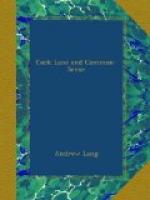The weakest point in the whole anecdote and theory is in the statement, ’oddly enough, she now learned for the first time that the house at which she was staying had the reputation of being haunted’ by the mediaeval personage. It certainly would be very odd if one picture in a house troubled ‘the inter-somnolent moments’ of a succession of people, who, perhaps, had never seen, or, like the lady, never attended to it. Such ‘troubles’ are very rare: very few persons have seen a dream which, in Mr. Sully’s words, ’left behind, for an appreciable interval after waking, a vivid after-impression, and in some cases, even the semblance of a sense perception’. Mathematicians may calculate the chances against a single unnoticed portrait producing this very rare effect, in a series of cases, so as to give rise to a belief in haunting, by mere casual coincidence. In the records of the Psychical Society, one observer speaks of seeing a face and figure at night, which he recognises next morning in a miniature on his chimney-piece. But, in this case, there was no story of haunting, there had been no series of similar impressions on successive occupants of the room, that is the circumstance which Mr. Sully finds ‘odd enough,’ a sentiment in which we may all agree with him. This is exactly the oddity which his explanation does not explain.
While psychological science, in this example, seems to treat matters of evidence rather laxly, psychical conjecture, on the other hand, leaves much unexplained. Thus Mr. Myers puts forward a theory which is, in origin, due to St. Augustine. The saint had observed that any one of us may be seen in a dream by another person, while our intelligence is absolutely unconscious of any communication. Apply this to ghosts in haunted houses. We may be affected by a hallucination of the presence of a dead man or woman, but he, or she (granting their continued existence after death), may know nothing of the matter. In the same way, there are stories of people who have consciously tried to make others, at a distance, think of them. The subjects of these experiments have, it is said, had a hallucination of the presence of the experimenter. But he is unaware of his success, and has no control over the actions of what old writers, and some new theosophists, call his ‘astral body’. Suppose, then, that something conscious endures after death. Suppose that some one thinks he sees the dead. It does not follow that the surviving consciousness (ex hypothesi) of the dead person who seems to be seen, is aware that he is ‘manifesting’ himself. As Mr. Myers puts it, ’ghosts must therefore, as a rule, represent—not conscious or central currents of intelligence—but mere automatic projections from consciousnesses which have their centres elsewhere,’ [Greek]: as Homer makes Achilles say, ’there is no heart in them.’ {156} All this is not inconceivable. But all this does not explain the facts, namely,




